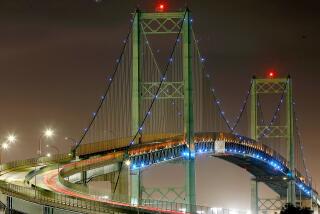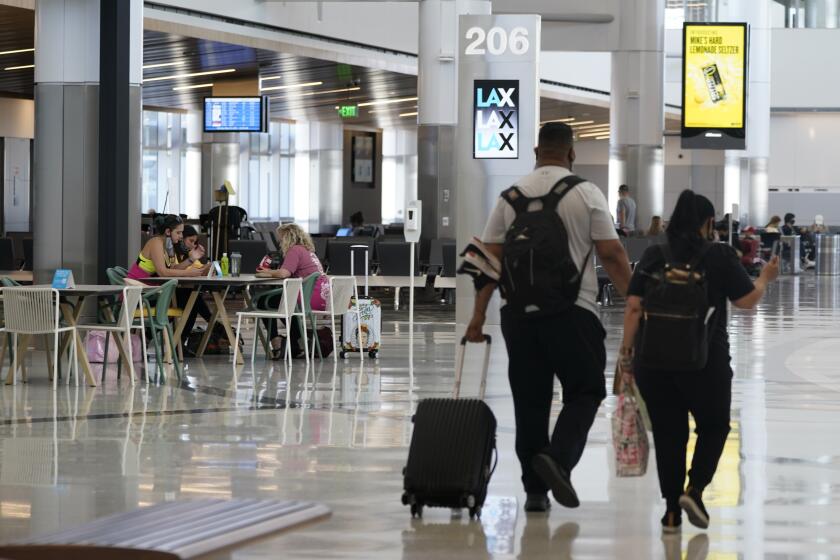Down the Road for Traffic Jams : Street Crews Attempt to Lessen Effects of Construction
- Share via
You have long since tired of reading the bumper sticker of the car in front proclaiming “I my,” or the windshield sign urging caution because a baby is aboard or an ex-spouse is in the trunk.
Again, it is your basic Los Angeles surface street traffic jam, and your nerves are frayed--this time for a different reason.
“We’ve had people drive by and swear at our workers,” David A. Reed said. “Some drivers have gotten so angry that they crash through the barricades and go right over the newly-laid asphalt.”
Reed helps preside over a necessary evil. He is assistant director in the city’s Bureau of Street Maintenance. “We have the largest municipal street system in the United States--6,500 miles of paved streets and 800 miles of alleys,” Reed said. “We spend $30 million a year, basically on resurfacing.
“Unavoidably, virtually everything we do disrupts traffic.”
Not that Reed and his people aren’t trying to keep blood pressures reasonably low:
--Having the choice of obstructing the morning rush hour or the one in the late afternoon, they opt for the early one. “Drivers don’t complain that much if they are interrupted on the way to work--but if we are lousing them up after a long day, when they are tired and on their way home, they don’t like that.”
--Consideration is being given to having more street work done at night, although that isn’t as easy as it is for Caltrans and its freeways.
--An effort always is made to keep some semblance of traffic flowing. “A minimum of one lane is kept open in each direction. And if we can, we try to have at least two lanes open in the direction of the heaviest flow of traffic.”
And although it seems that the work is always done on the roads you happen to have to use, consider this thought from Reed: “We are causing inconvenience for a relatively short period of time. We aren’t going to be back for many years, and you are going to wind up with a very good street on which to drive.”
By nationally accepted averages, an asphalt street requires major rehabilitation every 22 years. A major street might require work every 10 to 13 years, but a local street might last 40 to 50 years.
If you find yourself caught in one of the city’s decidedly unmusical jam sessions (save for the horns), it may be because of one of Los Angeles’ 150 to 160 miles of resurfacing being done this fiscal year. And this includes the preparatory work, namely first removing up to 2 inches of the old surface by large milling machines.
More than once you have found yourself thinking, because so much freeway work is done at night (more on that later), why not the surface streets?
“We do have to pay a labor differential of 5 1/2% for night work, but the major cost of any of our operations is asphalt and transportation,” Reed explained. “What decides night work is whether or not it is practical.”
Factors in the decision:
--It may be a commercial area where there are hotels and businesses which stay open at night, such as restaurants. “And even if it is a major urban street, a residential neighborhood may be nearby--an area where the ambient noise level drops so low that activity half-a-mile away will wake those people up,” the assistant director said. “The street equipment is noisy. By law, the trucks all must have safety backup warning devices, loud buzzers or bells, both piercing. In the daytime, you tend not to notice that as much.”
--Another problem of working at night is getting good quality control. “You require a lot of incidental lighting. Even at that, working with black asphalt at night and trying get good joints is difficult.”
--Temperatures are colder at night, and this makes it more difficult to pave. “Asphalt comes out hot. When it hits the street, the asphalt’s temperature will start dropping. It must stay within a certain high range to get the proper compaction with the rollers to build the pavement structure. If you can’t compact the material, you’ll get a job you might have to re-do.”
--It is more hazardous for the work force at night. “Our people get very nervous being out there when the bars let out at 2 a.m.”
Nevertheless, Reed went on, there are some projects that probably could be successfully done at night, to minimize inconvenience where there might be serious traffic problems--if the work can be done during the hot part of the year.
For instance, prior to the Olympics in 1984, a lot of the work on Century Boulevard was done at night to lessen the congestion that might have resulted from daytime work. “We talked to all the hotel managers, and they felt they had good enough soundproofing insulation put in to deal with the airport noise.”
What about weekends? “Jobs that couldn’t even be done effectively on a Saturday or a Sunday, such as around a shopping center, may be candidates for at least partial night work,” Reed said.
OK, but all you know on any given day is that there you are, plodding along in your car, saying to yourself, why me?
What happened before this scene was set in motion (or temporary stagnation)?
Plan in Motion
First off, it was all planned 18 months to two years ago. An early step was to notify the utility companies, which might have underground lines. “That gives them the chance to do any work they might have in mind before we resurface,” Reed explained. “Otherwise, except for emergencies, they will have to wait for five years afterwards.”
Members of the City Council are notified, in case they wish to pass the word to their affected constituents. Several weeks before the start of work, signs go up telling of a construction zone ahead.
“People should then be thinking of alternate routes,” the assistant director said. “Because at some point, they are going to be running into a delay.”
In most cases, paving will begin at 7 a.m. “From past experience,” Reed said, “we know that we get a third of our production done in the first two hours. The trucks are all there, everything is in readiness. We try to get off the street by 3:30 p.m., to make way for the rush hour traffic.”
Segue now to a freeway. Same problem--a traffic jam--perhaps caused by necessary maintenance. “The drivers sometimes take out their frustrations on our workers,” Chuck O’Connell said. “They’ll swear, maybe throw soft drink cans. We tell our guys, don’t react.”
O’Connell is chief of the maintenance field branch for District 7 of Caltrans, which encompasses Los Angeles, Orange and Ventura counties.
“We have 1,200 miles of highway,” O’Connell said. “Of those, 750 miles are freeway.
“The design life of concrete pavement is 20 years. And most of our freeways are pretty old now. The Pasadena Freeway is almost 48 years old, and has had no major rehabilitation up to now.”
John E. Reeves, chief of the construction branch for District 7 of Caltrans, said there are the never-ending problems of potholes, guard rail repairs, attenuators (which hopefully absorb the energy of crashes) median barrier repairs, sweeping (of shoulders), ramp work, landscape work and mudjacking, which involves forcing a cement mixture into drilled holes in order to raise concrete that has settled.
All of which means, somewhere along the line, freeway delays.
“Ordinarily, the older freeways are more in need of constant work,” O’Connell said, “but trucks are the biggest factor. That is one of the reasons they aren’t allowed on the Pasadena Freeway. The pavement was never designed for that kind of load.”
The largest number of trucks is carried by Interstate 5--the Santa Ana-Golden State. About 20% of the traffic on those freeways, the maintenance chief said, is truck traffic.
Freeway Trend
So the aging freeways are more and more in need of repair--and here is where a trend is developing:
“Little by little, the freeways are changing color,” Reeves said. “On a new freeway, we start off with concrete, because that will last longer to start off with. But most of our rehabilitation now is involving asphalt, black over white.”
Not only is it a matter of lower cost, he explained, but the laying of asphalt takes less time, and this means less time the public has to be kept off that stretch of freeway.
“We always want repair work to have the minimum impact on the public,” O’Connell said.
That portion would probably only see work on nights or weekends. In general, the cost is greater, both for labor and to get materials to the site.
On the other hand, certain types of tasks can realistically be done only during daylight hours--tree trimming, cleaning culverts, landscape maintenance. The employees have to see what they are doing.
For a typical freeway, after all the planning is done, signs posted in advance and announcements made, this is what follows:
“The crews show up between 4:30 a.m. and 5 a.m.,” O’Connell said. “We want to be on the job as soon as daybreak. We want to get in as many hours as we can before the traffic builds up.”
The first step is placing on the pavement those familiar orange cones. Up go the road construction signs, increasingly made out of fabric, which is not only easier for the workers to handle, but if hit by a driver, hold less likelihood of serious injury.
“If we are taking a lane, we send out a truck with flashing arrows,” the maintenance chief said.
The barrier trucks, or shadow trucks, are deployed to protect the workers. Sometimes, mostly in outlying areas, flagmen are stationed.
“If there is a bottleneck, it usually happens before the motorists arrive at the work site,” Reeves pointed out. “Once they are in, say, a single lane, things usually move pretty smoothly.”
More to Read
Sign up for Essential California
The most important California stories and recommendations in your inbox every morning.
You may occasionally receive promotional content from the Los Angeles Times.










